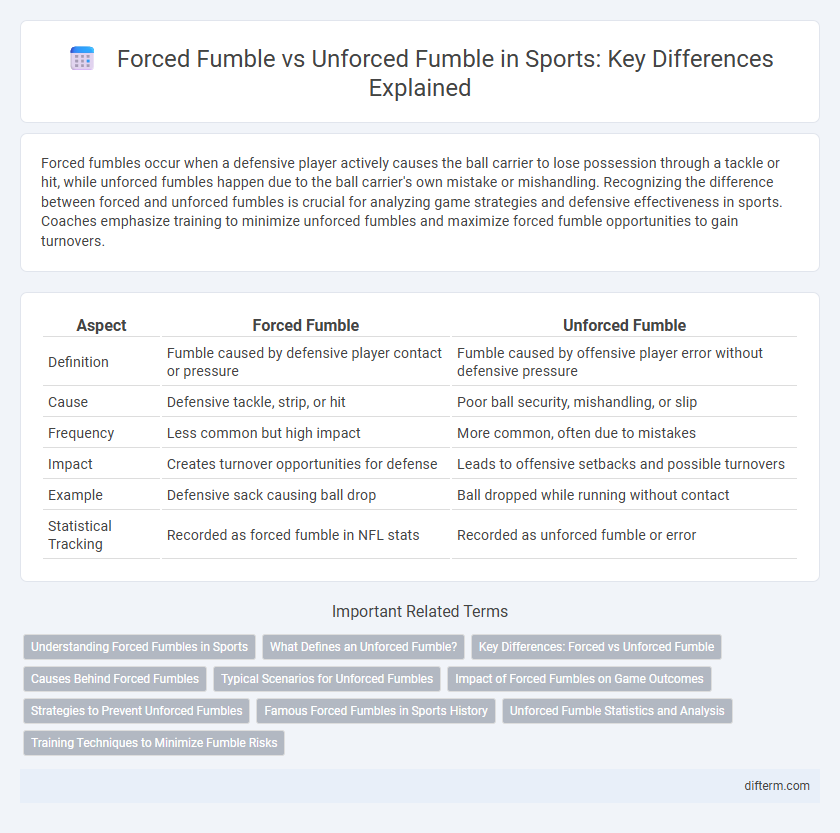Forced fumbles occur when a defensive player actively causes the ball carrier to lose possession through a tackle or hit, while unforced fumbles happen due to the ball carrier's own mistake or mishandling. Recognizing the difference between forced and unforced fumbles is crucial for analyzing game strategies and defensive effectiveness in sports. Coaches emphasize training to minimize unforced fumbles and maximize forced fumble opportunities to gain turnovers.
Table of Comparison
| Aspect | Forced Fumble | Unforced Fumble |
|---|---|---|
| Definition | Fumble caused by defensive player contact or pressure | Fumble caused by offensive player error without defensive pressure |
| Cause | Defensive tackle, strip, or hit | Poor ball security, mishandling, or slip |
| Frequency | Less common but high impact | More common, often due to mistakes |
| Impact | Creates turnover opportunities for defense | Leads to offensive setbacks and possible turnovers |
| Example | Defensive sack causing ball drop | Ball dropped while running without contact |
| Statistical Tracking | Recorded as forced fumble in NFL stats | Recorded as unforced fumble or error |
Understanding Forced Fumbles in Sports
Forced fumbles occur when a defensive player causes the ball carrier to lose possession through direct physical impact or strategic pressure, often leading to game-changing turnovers. These plays highlight the importance of defensive skill, such as tackling technique and awareness, in creating opportunities for recovery and momentum shifts. Distinguishing forced fumbles from unforced fumbles, which result from player errors without defensive contact, helps teams evaluate defensive effectiveness and improve tackling strategies.
What Defines an Unforced Fumble?
An unforced fumble in sports occurs when a player loses possession of the ball without any direct pressure or contact from the opposing team, typically due to a lapse in concentration or mishandling. It highlights a player's individual error rather than a defensive play, contrasting with a forced fumble where the defense causes the turnover through impactful tackles or strikes. Tracking unforced fumbles provides key insights into a team's ball security and the player's ability to maintain control under non-pressured situations.
Key Differences: Forced vs Unforced Fumble
Forced fumbles occur when a defensive player actively dislodges the ball from the ball carrier through tackles or hits, showcasing aggressive gameplay and strong defensive skills. Unforced fumbles happen without direct defensive pressure, often caused by the ball carrier's own mistakes like slipping or mishandling the ball. Analyzing the frequency and impact of forced versus unforced fumbles helps teams identify areas for improving defensive tactics and ball security strategies.
Causes Behind Forced Fumbles
Forced fumbles occur when a defensive player actively disrupts ball possession through tackles, strips, or hits that jar the ball loose. Key factors include precise timing, aggressive hands, and strategic positioning to exploit offensive vulnerabilities. Unlike unforced fumbles, forced fumbles result directly from targeted defensive actions aiming to create turnovers.
Typical Scenarios for Unforced Fumbles
Unforced fumbles typically occur during routine plays when a ball carrier loses control without direct contact from a defender, often due to poor grip, miscommunication, or slipping on the field. Common scenarios include mishandling the ball during a handoff, dropping it while attempting to adjust running speed, or fumbling after a deceptive move like a spin or cut. These lapses in ball security can drastically impact game momentum by giving the opposing team unexpected possession opportunities.
Impact of Forced Fumbles on Game Outcomes
Forced fumbles directly influence game outcomes by creating turnover opportunities that shift momentum and field position, often leading to scoring drives. Teams with higher forced fumble rates typically see improved defensive efficiency and increased chances of winning, as these turnovers disrupt offensive rhythms. Statistical analysis shows that forced fumbles correlate strongly with successful defensive units, emphasizing their critical role in determining football game results.
Strategies to Prevent Unforced Fumbles
Effective strategies to prevent unforced fumbles in sports revolve around improving ball security through consistent grip training and proper hand positioning during play. Strengthening hand and finger muscles enhances control, while drills focused on situational awareness reduce the likelihood of careless errors. Coaches emphasize repetitive practice of secure carrying techniques and immediate response to contact to minimize the chances of unforced turnovers.
Famous Forced Fumbles in Sports History
Famous forced fumbles in sports history have dramatically shifted the momentum of key games, with iconic moments such as Lawrence Taylor's forced fumble against Joe Theismann in the 1985 NFL season showcasing defensive dominance. These plays highlight the defense's ability to create turnover opportunities by applying intense pressure and strategic tackles, often resulting in game-changing outcomes. Forced fumbles are statistically significant indicators of defensive prowess, contributing to team success by disrupting offensive drives and creating scoring chances.
Unforced Fumble Statistics and Analysis
Unforced fumble statistics reveal critical insights into player ball-handling reliability, highlighting instances where turnovers occur without direct defensive pressure. Analysis of unforced fumbles emphasizes the importance of technique and focus, as these mistakes often result from player error rather than opponent intervention. Teams with lower unforced fumble rates typically exhibit stronger offensive consistency and reduced turnover-induced scoring opportunities for opponents.
Training Techniques to Minimize Fumble Risks
Training techniques to minimize fumble risks emphasize strengthening ball security through grip drills and repetitive hand positioning exercises. Coaches implement situational drills simulating forced fumble scenarios, enhancing players' awareness and reaction time under physical pressure. Consistent practice in maintaining core stability and proper body alignment reduces unforced fumbles caused by balance loss or poor handling.
forced fumble vs unforced fumble Infographic

 difterm.com
difterm.com